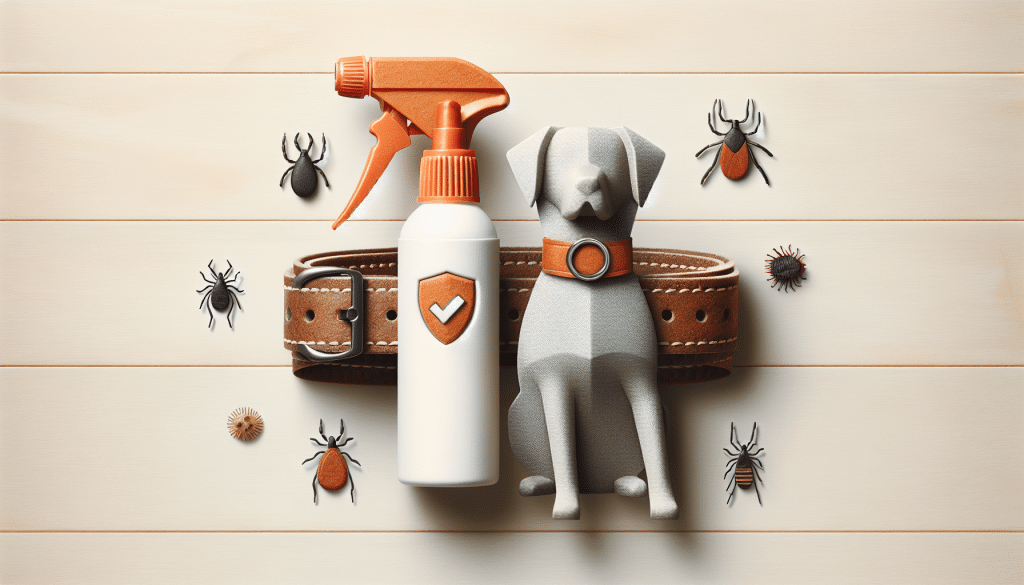Hey there! If you've got a furry friend at home, then you probably know how pesky fleas and ticks can be. These tiny creatures not only irritate your beloved dog, but they can also transmit diseases. But fret not! In this article, we're going to fill you in on the top 5 effective strategies to keep fleas and ticks off your four-legged pal. From regular grooming routines to using specialized products, we've got all the information you need to keep your pup happy and healthy. So let's jump right in and discover the best ways to tackle these annoying pests!

This image is property of images.unsplash.com.
Top 5 Effective Flea and Tick Prevention Strategies for Dogs
Fleas and ticks are not only a nuisance for our furry friends but can also pose serious health risks. It is essential to protect our dogs from these pesky parasites to ensure their well-being. Fortunately, there are several effective prevention strategies available. In this article, we will explore the top 5 strategies for preventing fleas and ticks in dogs and provide comprehensive information on each method.
1. Spot-On Treatments
Understanding Spot-On Treatments
Spot-on treatments are one of the most popular and effective methods for preventing fleas and ticks in dogs. These treatments come in the form of liquid drops that are applied directly to the dog's skin, usually between the shoulder blades or at the base of the neck.
How Spot-On Treatments Work
Spot-on treatments work by using active ingredients that are gradually released onto the dog's skin, spreading throughout the body. These ingredients are highly effective in killing fleas and ticks upon contact or ingestion. Spot-on treatments also have residual activity, providing continuous protection against reinfestation.
Choosing the Right Spot-On Treatment
When choosing a spot-on treatment, it is important to consider factors such as the dog's age, weight, and health condition. Different products may have varying efficacy, so consulting with your veterinarian is recommended to select the most suitable option for your dog.
Applying Spot-On Treatments Correctly
To ensure the effectiveness of spot-on treatments, it is crucial to apply them correctly. Follow the instructions provided by the manufacturer carefully. Part the fur to expose the skin, apply the treatment, and avoid bathing or grooming your dog immediately afterward to allow the treatment to fully absorb.
Safety Precautions for Spot-On Treatments
While spot-on treatments are generally safe, it is important to take certain precautions. Avoid using spot-on treatments meant for dogs on other animals, as they may contain chemicals that are toxic to cats or other pets. Additionally, be cautious of using spot-on treatments on pregnant or nursing dogs, as some products may not be suitable for them.

This image is property of images.unsplash.com.
2. Oral Medications
Understanding Oral Medications for Flea and Tick Prevention
Oral medications are another effective option for preventing fleas and ticks in dogs. These medications come in the form of chewable tablets or flavored treats that are administered orally. They work by releasing chemicals into the dog's bloodstream, which then kill fleas and ticks when they bite the dog.
How Oral Medications Work
Oral medications contain active ingredients that are absorbed into the dog's bloodstream, providing systemic protection against fleas and ticks. When the pests come into contact with the dog's blood, they are poisoned and killed.
Different Types of Oral Medications Available
There are various types of oral medications available for flea and tick prevention, including monthly and three-monthly options. Some medications are also effective against other parasites, such as heartworms or intestinal worms. Consult with your veterinarian to determine which oral medication is the most suitable for your dog's specific needs.
Choosing the Right Oral Medication
When selecting an oral medication, consider factors such as your dog's size, age, and overall health. Different medications may have specific age or weight restrictions, so it is important to follow the manufacturer's instructions and guidance from your veterinarian.
Administration and Safety Guidelines for Oral Medications
Follow the administration instructions provided with the medication carefully to ensure its effectiveness. It is crucial to administer oral medications with or after a meal to minimize the risk of gastrointestinal side effects. If your dog experiences any adverse reactions, such as vomiting or diarrhea, contact your veterinarian promptly.
3. Flea and Tick Collars
Understanding Flea and Tick Collars
Flea and tick collars are an effective and convenient method for preventing infestations in dogs. These collars are made with materials that release active ingredients to repel fleas and ticks, providing continuous protection over an extended period.
How Flea and Tick Collars Work
Flea and tick collars work by releasing active ingredients that are gradually distributed over the dog's skin and coat. These ingredients repel and kill parasites upon contact, creating a barrier against infestation.
Different Types of Collars Available
There are different types of flea and tick collars available, varying in their active ingredients and duration of effectiveness. Some collars offer protection against other pests, such as mosquitoes or lice. It is essential to choose a collar that is specifically designed for dogs, as collars meant for other animals may contain chemicals that are toxic to them.
Choosing the Right Collar
When selecting a flea and tick collar, consider your dog's size, age, and any specific health conditions. Certain collars may be more suitable for smaller or larger dogs, and some may not be recommended for puppies or pregnant dogs. Consult with your veterinarian to determine the most appropriate collar for your furry friend.
Using and Maintaining Flea and Tick Collars
Follow the manufacturer's instructions for properly fitting the collar and adjusting its length. It is important to regularly check the collar for signs of wear or damage, as a broken collar may reduce its effectiveness. If the collar becomes wet, be sure to take it off and dry it before putting it back on your dog. Keep in mind that flea and tick collars should not be used as a substitute for regular grooming or other preventive measures.

This image is property of images.unsplash.com.
4. Regular Grooming Practices
Importance of Regular Grooming
Regular grooming plays a vital role in preventing fleas and ticks in dogs. Grooming not only helps keep your dog looking and feeling their best but also allows for early detection of any potential pest infestations.
Brushing and Combing
Brushing and combing your dog's coat regularly can help remove any fleas or ticks that may have attached themselves. Use a fine-toothed comb to carefully check for any parasites and remove them promptly. Focus on areas where fleas and ticks commonly hide, such as around the ears, neck, and tail.
Bathing and Shampooing
Regular bathing with a flea and tick shampoo can help eliminate existing pests and provide some protection against future infestations. Be sure to use a specialized shampoo specifically designed for dogs, as human shampoo or other cleaning products may be too harsh for their skin.
Trimming Hair and Nails
Keeping your dog's hair and nails trimmed can also help prevent fleas and ticks. Parasites are more likely to hide and thrive in long and overgrown hair. Additionally, shorter nails reduce the chances of ticks hitchhiking into your home, as they are less likely to get caught in the fur.
Checking for Fleas and Ticks during Grooming
During grooming sessions, be vigilant in checking for signs of fleas and ticks. Look for any unusual redness, swelling, or itching, as these may indicate the presence of parasites. If you spot any concerns, consult with your veterinarian for appropriate measures and treatment options.
5. Environmental Control
Understanding the Importance of Environmental Control
Effective flea and tick prevention involves not only treating your dog but also addressing their living environment. By controlling the environment, you can significantly reduce the risk of reinfestation and create a safer space for your furry friend.
Keeping the Living Space Clean
Regularly cleaning and vacuuming your home can help eliminate any fleas, ticks, or eggs that may be present. Pay close attention to areas where your dog spends most of their time, such as bedding, furniture, and carpeted floors. Washing your dog's bedding regularly with hot water can also help eliminate any parasites.
Eliminating Fleas and Ticks in the Yard
Treat your yard with appropriate pesticides or natural alternatives to kill and repel fleas and ticks. Mow the grass regularly, remove any debris or clutter, and keep the yard well-maintained to minimize potential hiding places for parasites. Consider using nematodes, which are beneficial microscopic worms that feed on flea larvae in the soil.
Preventing Reinfestation Indoors
To prevent reinfestation indoors, it is important to be diligent in maintaining a clean and hygienic environment. Regularly vacuuming, cleaning your dog's bedding, and treating your home with appropriate products can help control any potential flea or tick infestations.
Other Tips for Effective Environmental Control
In addition to regular cleaning and yard maintenance, there are other measures you can take to enhance environmental control. These include removing any standing water sources, keeping wild animals away from your yard, and avoiding areas that are known to be infested with fleas and ticks.
With these effective flea and tick prevention strategies, you can ensure the health and happiness of your beloved dog. Remember to consult with your veterinarian before implementing any new preventive measures, as they can provide personalized guidance based on your pet's specific needs and circumstances.



